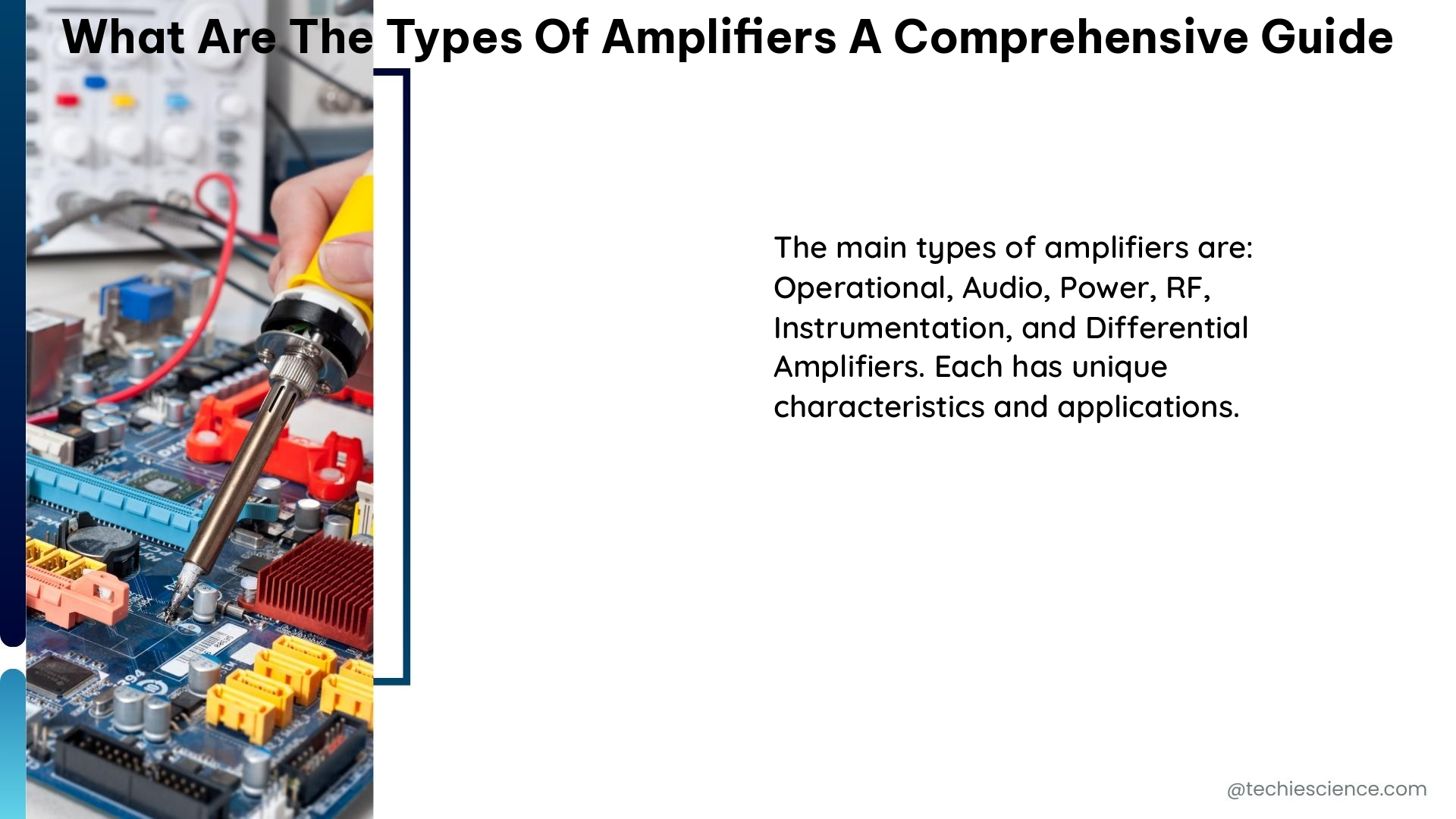Amplifiers are essential components in electronic circuits, responsible for increasing the strength or magnitude of a signal. They come in various types, each with its own unique characteristics, applications, and design considerations. This comprehensive guide will delve into the different types of amplifiers, their operational principles, and their key specifications, providing a valuable resource for electronics students and enthusiasts.
Linear Amplifiers
Operational Amplifiers (Op-Amps)
Operational amplifiers, or op-amps, are high-gain voltage amplifiers widely used in filtering, measuring, and mathematical operations. These versatile devices are characterized by their ability to perform a wide range of analog signal processing tasks, such as amplification, summation, integration, and differentiation.
One of the most popular op-amp models is the LM741, which has a typical voltage gain of around 200,000. Op-amps are designed to operate in a linear region, where the output voltage is directly proportional to the input voltage. This linear behavior makes them suitable for applications that require precise control and manipulation of analog signals.
Bipolar Junction Transistor (BJT) Amplifiers
Bipolar junction transistor (BJT) amplifiers are another type of linear amplifiers, which come in two main configurations: PNP and NPN. These transistors are widely used in various electronic circuits, including audio amplifiers, radio frequency (RF) amplifiers, and power supplies.
Common examples of BJT amplifiers include the 2N3904 (NPN) and 2N3906 (PNP) transistors, which have typical gain (beta value) ranging from 100 to 300. The choice between PNP and NPN transistors depends on the specific circuit requirements and the desired biasing conditions.
Power Amplifiers

Power amplifiers are designed to handle and amplify high-power signals, making them suitable for applications that require significant output power, such as audio systems, radio transmitters, and industrial equipment.
Classes of Power Amplifiers
Power amplifiers can be classified into different classes based on their operational characteristics and efficiency:
-
Class A Amplifiers: Class A amplifiers offer high fidelity and low distortion, but they are relatively inefficient, with a maximum theoretical efficiency of 25%. An example of a Class A amplifier is the JLH1969.
-
Class D Amplifiers: Class D amplifiers, also known as switching amplifiers, can achieve efficiencies over 90% by operating the output devices as switches rather than linear devices. These amplifiers are widely used in applications where power efficiency is crucial, such as in audio systems and power supplies.
RF Power Amplifiers
Radio frequency (RF) power amplifiers are a specialized type of power amplifiers used in various communication systems, such as broadcasting, cellular networks, and satellite communications. These amplifiers operate at frequencies ranging from 87.5 to 108 MHz for FM radio, with power outputs ranging from a few milliwatts in mobile devices to several kilowatts in radio transmitters.
The design of RF power amplifiers requires careful consideration of factors such as frequency response, linearity, and efficiency to ensure optimal performance and compliance with regulatory standards.
Amplifier Components and Design Considerations
Amplifier design involves the selection and integration of various electronic components, such as transistors, resistors, and capacitors. Some common components used in amplifier circuits include:
- Transistors: The BC548 is a popular NPN bipolar junction transistor used in amplifier circuits.
- Resistors: 1kΩ resistors are often used in amplifier circuits for biasing and load balancing.
- Capacitors: 10μF capacitors are commonly employed in amplifier circuits for coupling, bypassing, and filtering purposes.
When designing an amplifier circuit, understanding schematic diagrams is crucial, as each symbol represents a specific electronic component. The design process must balance various factors, such as gain, bandwidth, stability, and noise, to achieve the desired performance characteristics.
Key Amplifier Specifications
Amplifiers can be characterized by several measurable and quantifiable specifications, which are essential for understanding their operational capabilities and limitations. Some of the key amplifier specifications include:
- Voltage Gain (Av): The ratio of the output voltage to the input voltage.
- Current Gain (Ai): The ratio of the output current to the input current.
- Power Gain (Ap): The ratio of the output power to the input power.
- Input Impedance (Zin): The resistance offered by the amplifier input to the signal source.
- Output Impedance (Zout): The resistance offered by the amplifier output to the load.
- Bandwidth (BW): The range of frequencies over which the amplifier can function effectively.
- Efficiency (η): The ratio of the output power to the input power, usually expressed as a percentage.
- Total Harmonic Distortion (THD): The ratio of the sum of the powers of all harmonic components to the power of the fundamental frequency.
- Signal-to-Noise Ratio (SNR): The ratio of the signal power to the noise power.
- Slew Rate: The maximum rate of change of the output voltage with respect to time.
Understanding these specifications is crucial when selecting or designing an amplifier for a specific application, as they directly impact the amplifier’s performance and suitability for the intended use.
Conclusion
This comprehensive guide has explored the various types of amplifiers, their operational characteristics, and their key specifications. From linear amplifiers like op-amps and BJT amplifiers to power amplifiers, including Class A, Class D, and RF power amplifiers, the guide has provided a detailed overview of the amplifier landscape.
By understanding the components, design considerations, and measurable specifications of amplifiers, electronics students and enthusiasts can make informed decisions when selecting or designing amplifier circuits for their projects and applications.
References
- Amplifiers in Electrical Engineering Courses: a Comprehensive Guide
- Types of Audio Amplifiers – Analog Devices
- Audio system measurements – Wikipedia

The lambdageeks.com Core SME Team is a group of experienced subject matter experts from diverse scientific and technical fields including Physics, Chemistry, Technology,Electronics & Electrical Engineering, Automotive, Mechanical Engineering. Our team collaborates to create high-quality, well-researched articles on a wide range of science and technology topics for the lambdageeks.com website.
All Our Senior SME are having more than 7 Years of experience in the respective fields . They are either Working Industry Professionals or assocaited With different Universities. Refer Our Authors Page to get to know About our Core SMEs.